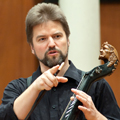
Thilo Hirsch
- thilo.hirsch@unibe.ch
- Postal Address
- Universität Bern
Graduate School of the Arts and Humanities | GSAH
Studies in the Arts | SINTA
Thilo Hirsch
Muesmattstrasse 45
3012 Bern
Thilo Hirsch
Thilo Hirsch studied viol and singing at the Schola Cantorum Basiliensis (SCB). Solo engagements with numerous international ensembles for concerts as well as CD and radio recordings have taken him across Europe, to North Africa, North and South America, and to Japan. Since 1991 he has been artistic director of the ensemble arcimboldo (www.arcimboldo.ch), with whom he has recorded several CDs. From 2007 to 2015 Thilo Hirsch was co-director of three SCB research projects, funded by the Swiss National Science Foundation (SNSF), devoted to reconstructing historical instruments in connection with their repertoire (La Grande Écurie / Early bowed Instruments around 1500, Part I: The Italian Viola da gamba / Part II: Groß Geigen, Vyolen, Rybeben). The 'audible' results of these research projects were documented in concerts as well as on CDs recorded by the ensemble arcimboldo. Between 2015 and 2018 he has been working on the evidence-based reconstruction of a Spanish Renaissance vihuela de arco. A research which included also ethnomusicological studies on the andalusi-playing technique in Morocco (funded by ProHelvetia). In 2018/19 Thilo Hirsch studied ethnomusicology at the University of Bern and from October 2019 he is project leader of a SNSF-research project at the Bern University of the Arts in collaboration with the University of Bern on the topic “Rabab & Rebec - Research on skin-covered bowed string instruments of the late Middle Ages and the early Renaissance, and their reconstruction”, about which he is writing his dissertation at the University of Bern.
Supervisors
Prof. Dr. Britta Sweers, Universität Bern, Institut für Musikwissenschaft
Prof. Dr. Thomas Gartmann, Leiter Forschung, Hochschule der Künste Bern HKB
Doctoral project
Rabab & Rebec – Erforschung Research on skin-covered bowed string instruments of the late Middle Ages and the early Renaissance and their reconstruction (working title)
The two musical instruments Rabab and Rebec, which had an animal skin as top, were among the most important bowed string instruments of the 14th-16th century and are still played in a similar form in Morocco today. The aim of this dissertation is the theoretical and practical investigation of this special type of instrument, which has so far received little attention either in musicological research or in the historically informed performance practice.
The Rabab, also known as “rabé morisco” in the 14th century, originated in al-Andalus, the part of Spain under Muslim rule until the fall of Granada in 1492. From here Rabab and Rebec spread to large parts of Europe and until the early 16th century they belonged to the most important European bowed string instruments beside the fiddle (and the Renaissance viol). With a critical analysis of the preserved sources, conclusions are to be drawn about the construction, playing technique, sound, repertoire and cultural context of this type of instrument. In addition, new ethnomusicological sources will be collected during field research in Morocco and related to the historical sources. Based on the knowledge gained, models for a reconstruction of the instruments will be developed and tested both acoustically and in practice in the sense of an “experimental musicology”. Special attention is paid thereby to possible “feedback effects” of the practical testing on the understanding of the sources.
Research priorities
Bowed string instruments, Middle Ages/Renaissance, Historically informed performance practice, Islam (Spain), Musicology, Organology, Ethnomusicology, Experimental musicology
